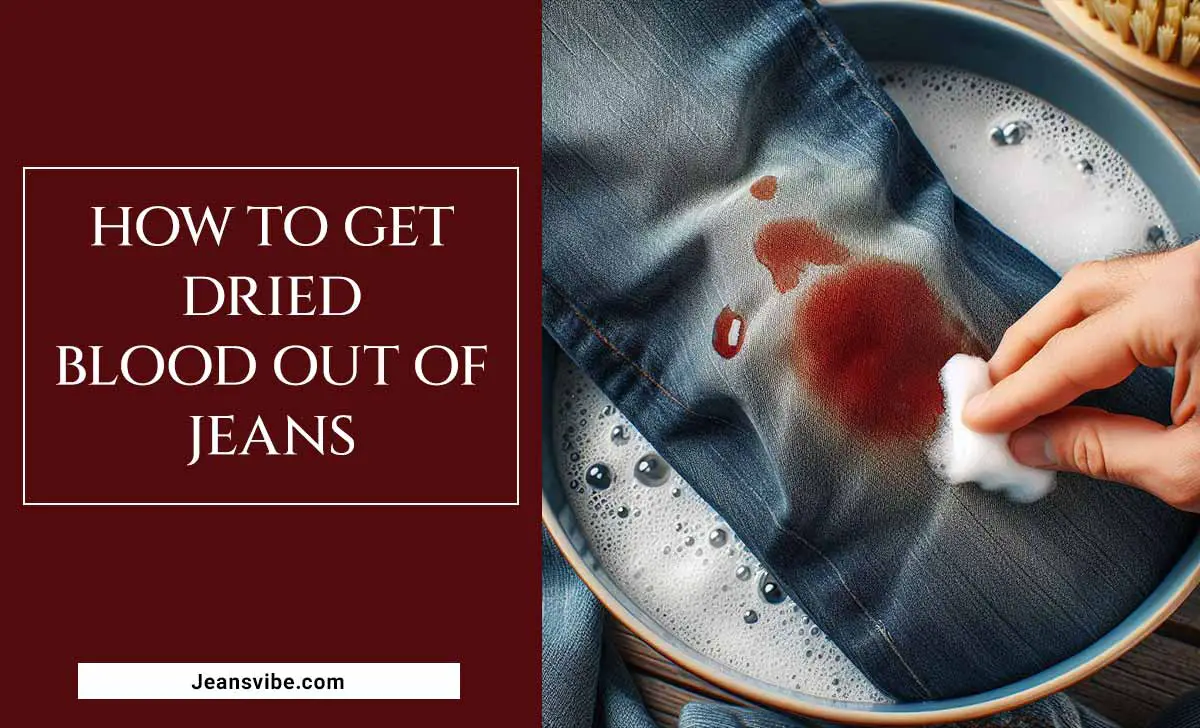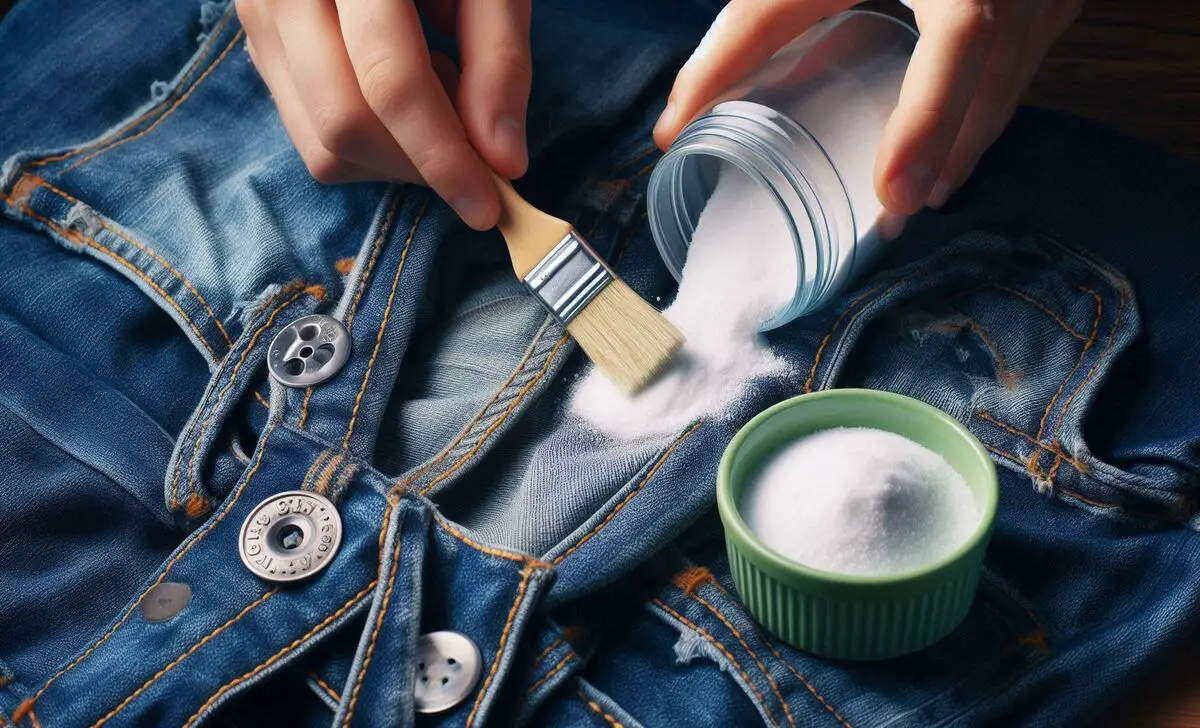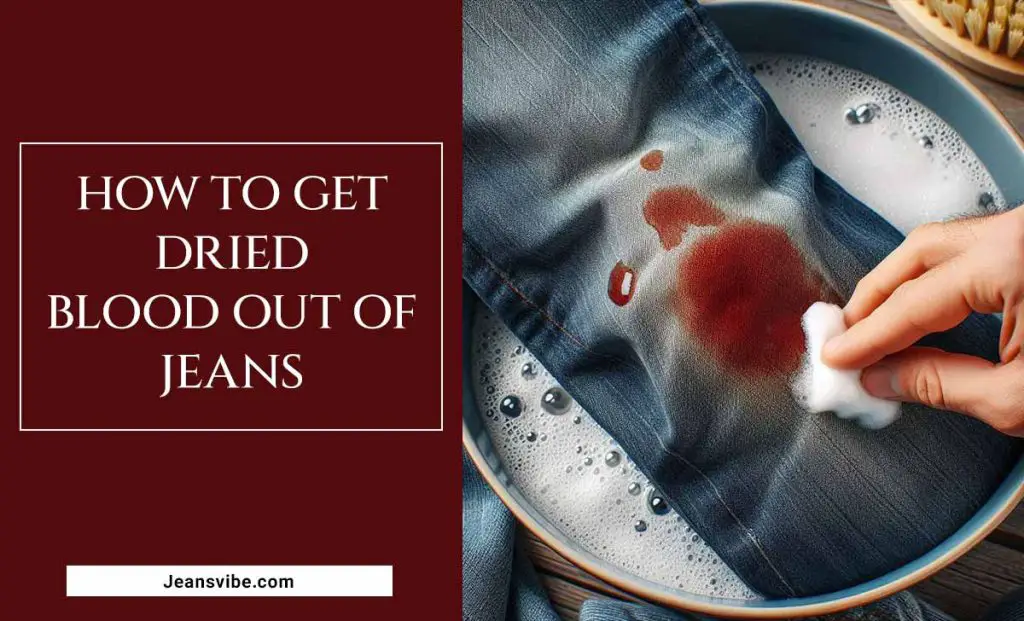Dealing with dried blood stains on jeans is somewhat disgusting. You can successfully remove the stain using the right approach without harming the fabric.
Blood stains, once dried, bond strongly to the fibers. This is why it’s essential to act with care. The key to effective stain removal lies in using cold water, as hot water can set the stain further.
Pre-treating the area with common household items like hydrogen peroxide, baking soda, or salt can help break down the blood before washing. This guide will walk you through various methods and tips to restore your jeans, ensuring the fabric remains intact and the stain is effectively removed.

Materials Needed
- Cold water
- Hydrogen peroxide or white vinegar
- Baking soda or salt
- Dish soap or liquid laundry detergent
- Soft brush (e.g., toothbrush)
- Clean cloth or sponge
How To Get Dried Blood Out Of Jeans In Different Ways

When dealing with dried blood stains on jeans, it’s essential to act quickly, as fresher stains are easier to remove. Always check the fabric type, as different materials may require specific care.
Use cold water for treatment since hot water can set the stain, and be sure to test any cleaning solution on a small, inconspicuous area first to avoid damage. Avoid putting the jeans in the dryer until the stain is completely gone, as heat can set it. Lastly, be patient; sometimes, multiple treatments are necessary to fully eliminate the stain.
Rinse With Cold Water

- Place the stained area under cold running water.
- Rinse from the back of the stain to push out the blood.
- For fresh blood stains, act quickly for best results.
- Use a stain remover or hydrogen peroxide for stubborn stains.
Start by placing the stained area under cold running water to effectively tackle a dried blood stain on the jeans. This helps to loosen and push the blood out of the fabric. Rinse from the back of the stain to ensure the blood is forced out rather than pushed further into the fabric.
This technique is crucial in the initial stages of blood stain removal for fresh blood stains. Applying a stain remover or a mixture of hydrogen peroxide and water before rinsing can enhance the cleaning process if dealing with a stubborn stain. Following these steps can significantly improve your chances of completely removing the blood stain.
Pre-Treatment
Pre-treatment is crucial for effective stain removal when dealing with old blood stains on delicate fabrics like jeans. Mix hydrogen peroxide or white vinegar with water in a 1:1 ratio. Apply this mixture to the stained area and let it sit for 5-10 minutes to break down the blood.
This approach helps loosen the stain before washing. For fabrics that require special care, such as those needing dry cleaning, it’s important to follow specific instructions or consult a professional to avoid damage. Using these laundry tips can improve your chances of completely removing the stain while maintaining the fabric’s integrity.
- Mix hydrogen peroxide or white vinegar with water (1:1 ratio).
- Apply the mixture to the stained area.
- Let it sit for 5-10 minutes.
Scrubbing
To tackle a stubborn blood stain, such as an old blood stain or period blood, gently scrub the area with a soft brush to help loosen the dried blood. For particularly challenging stains, like those mixed with oil or other protein stains, you can sprinkle meat tenderiser on the stain to break down the proteins in the blood.
After scrubbing, rinse the area with cold water and follow up with a stain treatment or a paste made from baking soda and water before washing. This method helps to lift the blood while preserving the fabric’s integrity.
Apply Baking Soda Or Salt

To address a dried blood stain, essentially a protein stain, you can use baking soda or salt to treat the issue effectively. Sprinkle baking soda or salt over the stained area, allowing it to sit for 30 minutes. These substances work to absorb and lift the blood from the fabric fibres. This method is particularly useful for tough stains on both white and coloured clothes.
After letting it sit, gently brush off the baking soda or salt and rinse the jeans in cold water before washing them. This technique helps break down the blood protein, making it easier to remove the stain without damaging the fabric.
Wash With Soap

To tackle a dried blood stain on denim jeans, apply dish soap or liquid laundry detergent directly to the stain. Use a damp cloth to rub the fabric together gently or a brush to work the soap into the dried stain for a more thorough approach. This method helps to break down the blood’s proteins and lift the stain from the fabric.
After treating the stain, rinse the area with cold water and launder the jeans as usual. Act promptly, especially if the bloodstain is relatively fresh, for the best results to prevent it from setting further.
Rinse And Repeat
To tackle dried blood stains on jeans, begin by rinsing the stained area with cold water to remove excess blood. Use a paper towel to gently blot the stain, absorbing as much blood as possible. For colored fabrics, be cautious with stain removers and avoid using hot water, which can set the stain.
If necessary, apply a stain-fighting solution like hydrogen peroxide or a baking soda paste, then rinse with cold water. Repeat the process as needed until the stain is completely removed. For best results, wash the jeans in a cold wash to prevent any residual stain from setting.
Launder
To tackle dried blood stains on jeans, begin by blotting the area with a paper towel to remove excess blood. Soak the stained section in cold water to help loosen the blood. For persistent stains, apply a cleaning solution- such as a mixture of hydrogen peroxide and water or a baking soda paste- and let it sit before rinsing.
Washing the jeans in a washing machine on a cold cycle is important to avoid setting the stain. Air drying the jeans is recommended to remove the stain completely before using heat, which could put any remaining traces. Be cautious with colored fabrics and test cleaning solutions on an inconspicuous area first to prevent damage.
- Blot excess blood with a paper towel.
- Soak in cold water.
- Apply a stain-fighting solution.
- Wash in a cold cycle.
- Air dry to ensure stain removal.
- Test solutions on colored fabrics first.
Conclusion
Removing dried blood from jeans requires patience and the right materials. Always use cold water and avoid heat, which can permanently set the stain. Remember that patience is key, as some stains may need repeated efforts for complete removal. You can tackle even the toughest blood stains with the right approach and keep your favorite jeans looking great.
Frequently Asked Questions
1.Can I Use Hot Water To Remove Blood Stains?
Hot water can set the blood stain, making removing it more difficult. Always use cold water to rinse and treat blood stains to prevent them from settling into the fabric.
2.What If Hydrogen Peroxide Is Not Available?
If hydrogen peroxide isn’t available, you can use white vinegar as an alternative. Vinegar is effective at breaking down blood stains and can help lift the stain from the fabric.
3.How Long Should I Let The Pre-Treatment Sit On The Stain?
Allow the pre-treatment solution, whether it’s hydrogen peroxide or vinegar, to sit on the stain for 5-10 minutes. This gives the solution time to break down the stain before you scrub it.
4.Is It Necessary To Use Both Baking Soda And Salt?
No, it is not necessary to use both baking soda and salt. Either one can be effective for lifting the stain. Choose the one you have on hand or prefer for treating the stain.
5.Can I Use Regular Laundry Detergent Instead Of Dish Soap?
Yes, regular liquid laundry detergent can be used to treat blood stains. It’s effective at breaking down proteins in the blood, similar to dish soap.
6.Why Should I Air-Dry The Jeans?
Air drying is recommended to remove the stain before applying heat from a dryer. Heat can set any remaining stain, making it nearly impossible to remove.
7.What If The Stain Doesn’t Come Out After One Attempt?
Repeat the process if the stain doesn’t appear after the first attempt. Blood stains, especially if set into the fabric, can sometimes require multiple treatments to be fully removed.











